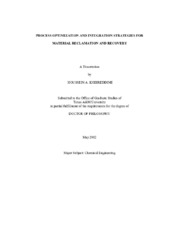| dc.description.abstract | Industrial facilities are characterized by the significant usage of natural resources and the massive discharge of waste materials. An effective strategy towards the sustainability of industrial processes is the conservation of natural resources through waste reclamation and recycles. Because of the numerous number of design alternatives, systematic procedures must be developed for the effective synthesis and screening of reclamation and recycle options. The objective of this work is to develop systematic and generally applicable procedures for the synthesis, design, and optimization of resource conservation networks. Focus is given to two important applications: material utilities (with water as an example) and spent products (with lube oil as an example). Traditionally, most of the previous research efforts in the area of designing direct-recycle water networks have considered the chemical composition as the basis for process constraints. However, there are many design problems that are not component-based; instead, they are property-based (e.g., pH, density, viscosity, chemical oxygen demand (COD), basic oxygen demand (BOD), toxicity). Additionally, thermal constraints (e.g., stream temperature) may be required to identify acceptable recycles. In this work, a novel approach is introduced to design material-utility (e.g., water) recycle networks that allows the simultaneous consideration of mass, thermal, and property constraints. Furthermore, the devised approach accounts for the heat of mixing and for the interdependence of properties. An optimization formulation is developed to embed all potential configurations of interest and to model the mass, thermal, and property characteristics of the targeted streams and units. Solution strategies are developed to identify stream allocation and targets for minimum fresh usage and waste discharge. A case study on water management is solved to illustrate the concept of the proposed approach and its computational aspects.
Next, a systematic approach is developed for the selection of solvents, solvent blends, and system design in in extraction-based reclamation processes of spent lube oil Property-integration tools are employed for the systematic screening of solvents and solvent blends. The proposed approach identifies the main physical properties that influence solvent(s) performance in extracting additives and contaminants from used lubricating oils (i.e. solubility parameter (delta), viscosity (v), and vapor pressure (p)). The results of the theoretical approach are validated through comparison with experimental data for single solvents and for solvent blends. Next, an optimization formulation is developed and solved to identify system design and extraction solvent(s) by including techno-economic criteria. Two case studies are solved for identification of feasible blends and for the cost optimization of the system. | en |


